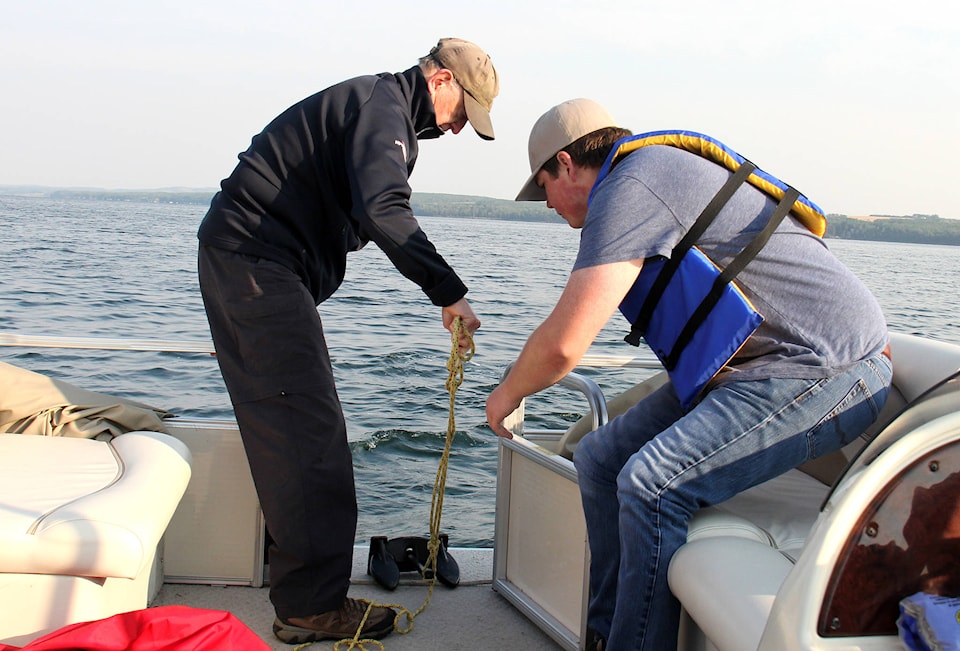Sylvan Lake is like a 42 square km rain gauge that captures water received as precipitation and runoff within the boundary of the 150 square km watershed. Most of that precipitation leaves as quickly as it arrives. What’s left requires understanding, caution and stewardship because there is little room for error in water use.
This second SLWSS article explains the case history of what happened during the dry summer of 2018 when the lake level dropped by 0.25 m between June 10 and September 15, a loss of more than 10 million cubic metres or millions of tonnes (Mt) of water. That is several times greater than the combined annual quantity of groundwater withdrawn for use by the Town of Sylvan Lake, Summer Villages and industrial and agricultural users.
To get calibrated, one million tonnes of water (1 Mt) would fill a giant cube that is 100 m on each edge. That’s 1 billion litres of water!
The water balance works just like a bank account balance. Water is deposited as precipitation, then withdrawn by the natural processes of evaporation of the lake, transpiration of trees and crops, and by seepage into the ground. Human impact reduces the balance too by pumping well water for domestic use then exporting it across the watershed boundary as wastewater. The lake level is a real-time indicator of the water balance.
Currently, the lake level is 936.742 metres above mean sea level as surveyed by Environment Canada at the official monitoring station in the marina. The lake water volume is currently about 428 Mt.
Here are the Sylvan Lake water balance account transactions in 2018 that explain how a dramatic 0.25 m drop in lake level occurred between June 10 and September 15 by an evaporative loss of 10.5 Mt of water, about 2.5 percent of the lake volume.
At the same time, about 0.248 m of rain fell inside the perimeter of the 150 square km Sylvan Lake watershed, according to data from the Alberta Agriculture weather station at Hespero. That added 37.2 Mt of water. The land area of 108 square km received 26.8 Mt, and the lake area of 42 square km received 10.4 Mt.
Not much precipitation stayed around on the land in 2018, because 21.4 Mt (about 80 per cent) evaporated and transpired and blew away in the wind. Of the remaining 5.4 Mt, about half flowed off the land into the lake and the other half infiltrated into the soil to become groundwater. About 2.0 Mt of groundwater discharged into the lake from the mythical underground springs.
Those rates of recharge and loss of groundwater are important because the watershed population depends on that subsurface inventory for survival. Infiltration of rain must keep up with well water withdrawal to avoid depletion of the critical groundwater resource.
The very large 24.0 Mt loss of water from the lake (all the precipitation, plus the lost lake water) occurred by evaporation, at a steady rate of 2.6 mm per day. Beachgoers could almost see that huge quantity of water disappearing in front of their eyes at a rate of 108 million litres per day!
Included in the water balance losses for 2018 was the export of about 2 Mt of groundwater across the watershed boundary as municipal wastewater. In addition, some Town of Sylvan Lake stormwater flowed eastward through Cygnet Lake to the Red Deer River. Once transferred outside the watershed, that water cannot flow back.
In water balance summary, 37.2 Mt was deposited on the watershed, and 48.4 Mt was lost for a 2018 balance of minus 10.1 Mt. Creation of that deficit was easy to see since the lake level dropped as that water disappeared.
Groundwater is a different story because it is stored out of sight unless well water levels are monitored. The entire watershed community depends on that supply. After use in domestic and industrial applications, wastewater is exported across the watershed boundary and is permanently removed from the inventory.
One Mt of groundwater is replenished slowly at estimated regional infiltration rates of between 40 and 125 mm/year. That could require up to 25 square km of land area for recharge, that’s almost 6200 acres of land. An expanding population with an increasing demand for water also caps the land with impermeable buildings and roads and that alter stormwater rates and flow patterns. Urban development threatens the replenishment of the groundwater inventory and the water balance.
Two major groundwater studies have investigated regional groundwater supply: The Edmonton-Calgary Corridor Groundwater Atlas (2011) by AE-ERCB and the Sylvan Lake Groundwater Study by the Alberta Geological Survey (AGS). The AGS analysis raised a cautionary flag that our watershed is in a “no safe yield” area of Central Alberta.
There are opportunities for water conservation through community stewardship. Low Impact Development best landscaping practices can help to maintain water balance at all scales of land use from single properties, to major subdivisions, to farms and ranches, by attention to the factors that affect water balance and its management. BC municipalities do so.
What does the future hold? Sylvan Lake has not yet been guaranteed water supply from the Red Deer River. There is no “Plan H2O”. Other larger municipal users take priority. So does Buffalo Lake’s pumped- water level control, for its recreation convenience. Stewardship standards for our lake and groundwater resources need watershed-community attention.
For more information on water balance issues see https://slwss.org
